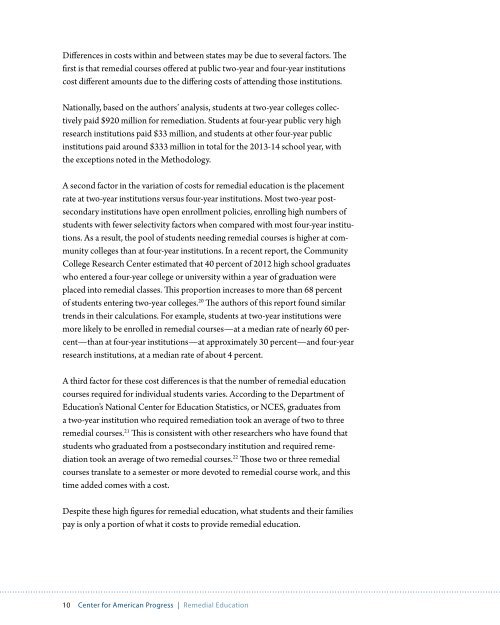Remedial Education
k8LkHA
k8LkHA
Create successful ePaper yourself
Turn your PDF publications into a flip-book with our unique Google optimized e-Paper software.
Differences in costs within and between states may be due to several factors. The<br />
first is that remedial courses offered at public two-year and four-year institutions<br />
cost different amounts due to the differing costs of attending those institutions.<br />
Nationally, based on the authors’ analysis, students at two-year colleges collectively<br />
paid $920 million for remediation. Students at four-year public very high<br />
research institutions paid $33 million, and students at other four-year public<br />
institutions paid around $333 million in total for the 2013-14 school year, with<br />
the exceptions noted in the Methodology.<br />
A second factor in the variation of costs for remedial education is the placement<br />
rate at two-year institutions versus four-year institutions. Most two-year postsecondary<br />
institutions have open enrollment policies, enrolling high numbers of<br />
students with fewer selectivity factors when compared with most four-year institutions.<br />
As a result, the pool of students needing remedial courses is higher at community<br />
colleges than at four-year institutions. In a recent report, the Community<br />
College Research Center estimated that 40 percent of 2012 high school graduates<br />
who entered a four-year college or university within a year of graduation were<br />
placed into remedial classes. This proportion increases to more than 68 percent<br />
of students entering two-year colleges. 20 The authors of this report found similar<br />
trends in their calculations. For example, students at two-year institutions were<br />
more likely to be enrolled in remedial courses—at a median rate of nearly 60 percent—than<br />
at four-year institutions—at approximately 30 percent—and four-year<br />
research institutions, at a median rate of about 4 percent.<br />
A third factor for these cost differences is that the number of remedial education<br />
courses required for individual students varies. According to the Department of<br />
<strong>Education</strong>’s National Center for <strong>Education</strong> Statistics, or NCES, graduates from<br />
a two-year institution who required remediation took an average of two to three<br />
remedial courses. 21 This is consistent with other researchers who have found that<br />
students who graduated from a postsecondary institution and required remediation<br />
took an average of two remedial courses. 22 Those two or three remedial<br />
courses translate to a semester or more devoted to remedial course work, and this<br />
time added comes with a cost.<br />
Despite these high figures for remedial education, what students and their families<br />
pay is only a portion of what it costs to provide remedial education.<br />
10 Center for American Progress | <strong>Remedial</strong> <strong>Education</strong>


